Repairs / maintenance
The first part of any retrofit plan is to design & implement a programme of repairs and maintenance.
What is it?
The first part of any retrofit plan is to design and implement a programme of repairs and maintenance to ensure you have a dry, sound building to work with. This can cover works such as repairs to the roof, chimney, guttering, window sills etc, as well as the removal of non-breathable materials. The purpose of the programme is to tackle issues of structural integrity, damp, water penetration and condensation.

The reason that it’s the first step is that it doesn’t make sense to spend money on (e.g.) solar pv if you haven’t first made sure your house is structurally sound and dry. See this understanding damp article for more information about keeping your home dry.
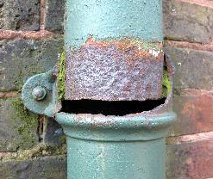
In previous generations, there was much more likely to be a regular maintenance routine for most houses. Checks, and maintenance such as lime washing, used to be part and parcel of owning a house. Nowadays home owners are more likely to introduce one-off changes such as new fitted kitchens, conservatories or interior decoration rather than having a property maintenance schedule in place. We’re less likely to have the necessary tools and knowledge to do the things our grandparents’ generation might have done.

From a materials perspective, there are more products from the petrochemical industry offering quick fixes to problems; but modern fixes are often incompatible with the fabric of the building, and can cause damage – for example covering up rising damp problems with vinyl wallpapers and paints instead of dealing with it.
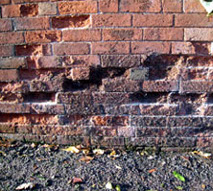
What are the benefits?
- getting your building dry and sound is the starting point for creating a home that is warm and comfortable
- getting the order right is important for maximum energy saving – so ‘fabric first’ – repairs and maintenance, followed by insulation, and then renewables
- having regular maintenance checks of your property means that you’ll catch problems early and save money by not having to undertake huge repair jobs
- making a plan helps you to manage your property confidently, know what jobs are coming up and budget for the work

Internal mould
What can I do?
As part of your overall retrofit plan, create a regular maintenance programme (such as cleaning out gutters twice a year, after the autumn leaf-fall and in the spring), and do a visual assessment of the property in the summer, starting on the outside first, from top to bottom, and then do the same on the inside. What you’re looking for is any damage on the outside that could affect the stability of the structure, or allow water / moisture to get in. See if you can tie in problems with causes – e.g. internal damp with external damage, or staining on a ceiling with a leaky appliance or pipework above.
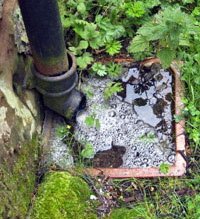
Outside
An outside visual check should cover:
- chimneys: chimney pot (is it missing?); or chimney cap (is it ventilated?); chimney flaunching or crown (is it cracked?); chimney stack (is the brickwork damaged? is any render or pointing cracked or missing? are there stains, damp patches or moss?)
- roof slates or tiles: any missing, cracked or slipped? are the ridge tiles all there?
- flashing: is it all there, and in the right position?
- guttering & fascias: all fixed solidly? any signs of blockage or damage – any patches on walls that look wet / have moss growing? any vegetation in the gutters?

Loose flashing - flat roofs (leaded bays or felt roofs): climb a ladder and inspect properly; is the fabric still well-seated and sealed? are there places where water puddles? check the path water takes – is there runoff provision that takes water away from the roof and from the base of the building?
- downpipes: fixed properly to gutters and walls? any leaks, or wet patches behind?
- walls: is there any spalling in the brickwork (crumbling of the face of the bricks)? if there is a lot, maybe it could do with a lime render, as too much spalding can turn your wall into a sponge; is render / pebbledash cracked or damaged? if so, moisture can get behind it and cause damp and frost damage; check around overflow pipes for damp, stains or moss; look for any gaps around pipework passing through walls.
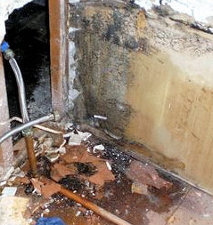
Result of leaking bath - window and door frames and sills: check condition / rot if wooden; check the seal is good between the window / sill and wall; is the sill angle right for shedding water? are there damp or mossy patches around or under windows?
- bay window stonework: any damage / softening of the stone? has it been painted with non-breathable coating? (moisture will find its way behind, then freeze, expand and crack the stonework) you may need to pay to have it removed, or scrape it off yourself.
- air bricks: are they blocked / covered over?
- ground next to the house: is it excessively wet? any moss? you have to make sure that water doesn’t stay next to the house.
- drains: do the downpipe outlets get water well away from your building and into a drainage system quickly? is the drain blocked or broken? if there is a soakaway, is it doing its job properly?
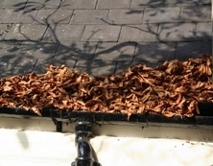
Leaves in gutter
Inside
- loft (unconverted): check rafters – look for wet / rot / salts; if it’s a warm loft (insulation at the rafter level), check there’s enough air flow on the felt side of the rafters; if it’s a cold loft (insulation at floor level), check the felt to see if it’s sound; turn off the light – can you see any chinks of light? (this only works in the daytime by the way); check that floor insulation doesn’t impede ventilation at the eaves – wood needs air flow to manage moisture and prevent rot.
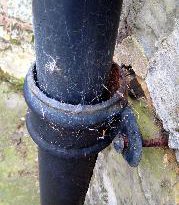
Loose downpipe - loft (converted): check for signs of damp around chimneys / anywhere on the ceiling.
- walls and ceilings generally: check for signs of damp; any mould or moisture sitting on the surface (condensation – especially bathrooms and kitchens)? any damp in the fabric (coming in from outside)? check around chimney breasts and in corners.
- ground floor walls: check for damp in the lower part of the walls (up to 1 metre – rising damp).
- plumbing: check around pipework and radiator valves for signs of dampness – everything should be dry; check around the toilet and u-bend.
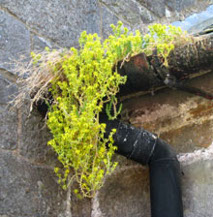
Vegetation in guttering - fireplaces: if you have a working stove, check condition of flue pipe and connections; stove or open fireplace – make sure the chimney is swept annually; if blocked-off chimney or closed fireplace, check ventilation to the chimney (if blocked chimney, should be air vents in each room to the chimney; if closed fireplace, should be a ventilation flap to be opened at regular intervals to stop the chimney ‘sweating’).
- floors: if you’re doing any work under your ground floor (e.g. insulation or draughtproofing), check condition of floor joists while you have access.
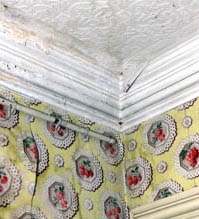
Water damage
These are not exhaustive lists – they don’t go into a great deal of detail, as this is an introductory factsheet, but they will give you some ideas. Read books for more detailed information on carrying out these tasks.






